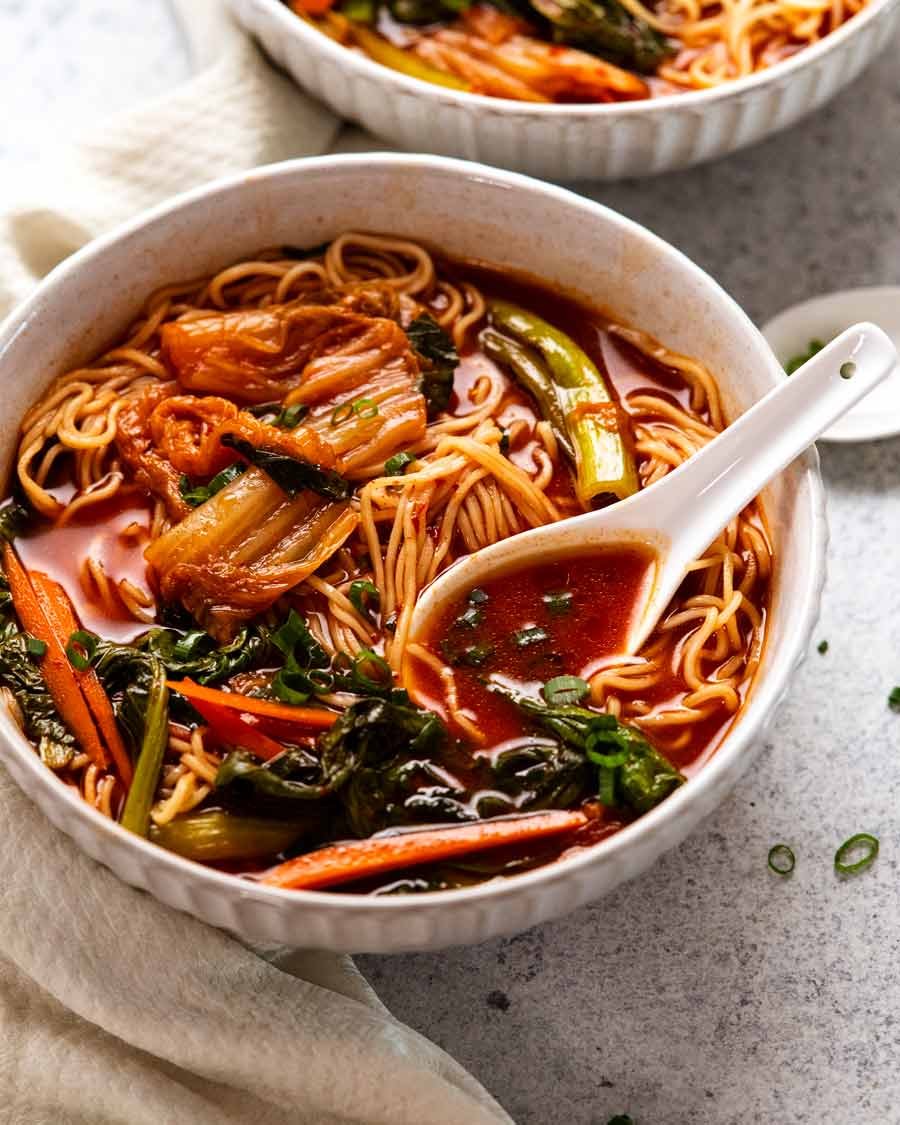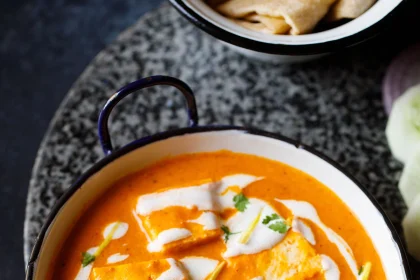This is a quick Korean noodle soup that’s healthy, packs big flavours and will curb your spicy Asian food cravings. The broth gets its flavour from gochujang and kimchi – express passes to flavour! (PS The soup looks far more fiercely spicy than it actually is, but this is not one for kids.)
Spice-meter
This soup is undeniably spicy from kimchi and gochujang, but not blow-your-head-off spicy. While I declare myself to be able to handle the heat, I actually can’t. But…….shhhhh!!! Let’s keep that secret between the two of us – can’t have everyone knowing what a chilli-wuss I actually am. 😂
Can’t handle spicy food at all? Make my Chinese Noodle Soup instead which has zero chilli it. You really can’t dial down the spiciness in this Korean noodle soup without affecting the flavour.

Really great spicy Asian soup broths that are easy to make are rare. Normally you need homemade stocks or obscure Asian sauces. So this Spicy Korean soup broth is a gold nugget recipe!

Key ingredients – Kimchi and Gochujang
The two key ingredients in this soup – both of which can be picked up at most everyday grocery stores – are kimchi and gochujang. Gochujang is a wickedly good Korean paste to have in your fridge – if only to make this soup over and over again!! More information below.


Kimchi is a traditional Korean pickle of fermented vegetables packed in tangy, spicy juice. The cabbage version (the most common type) is best in this soup. The cabbage acts like a mop for the sauce so you get extra flavour in the broth!
Widely available in the fridge section of large grocery stores or Asian stores these days. We use both the sauce in the jar as well as the vegetables for this recipe. The sauce is loaded with flavour, don’t waste it! Add it into stir fries or Asian soups for a hit of extra salt and spiciness.
Gochujang is a spicy Korean paste loaded with savory flavour. It makes an appearance regularly in my Korean recipes – including the Slow Cooked Beef Ribs in Korean BBQ Sauce which is a signature dish in my cookbook (it’s insanely easy for phenomenal results!).
Other broth ingredients
And here are the other ingredients required for the Korean soup broth:

Chicken stock/broth – use low sodium, else it might be too salty once all the sauces are added.
Fish sauce – Adds salt into the broth, and more flavour than just plain salt and even soy sauce.
Soy sauce – More salt into the broth (just using fish sauce is a little too fishy). Use either light or all purpose soy sauce. Not dark soy sauce, the flavour is too strong! More on different soy sauces here.
Chinese cooking wine – or mirin or dry sherry. Just a small amount adds depth of flavour and complexity to soups and sauces. Without, you’ll notice that the soup is missing “something”. Substitute with more fish sauce (see recipe notes).
Ginger and garlic – To infuse the broth with flavour.
Soup add-ins

I’ve used choy sum and carrots in this soup. But it’s one to make your own! Use whatever cookable vegetables you want.
- Kimchi – As per above, we use the juices in the jar to flavour the broth as well as the cabbage. Korean spicy goodness to the max!
- Noodles – Use any type you want. I like using thin egg noodles for this – dried ones. But the recipe will work fine with any noodles at all, just prepare according to packet directions.
- Choy sum – Love using Asian greens for quick-prep recipes. So quick to chop! Plus, a good contrast of textures – some fresh crunch from the stem and floppiness from the leafy part. Feel free to substitute with other Asian greens (bok choy, gai lan/Chinese broccoli etc)
- Carrot – For some crunch and lovely contrasting colour! I’ve cut it into batons but if you can’t be bothered, just slice it on an angle. It really doesn’t matter. 🙂
- Green onion – Fresh garnish! Optional.
How to make spicy Korean noodle soup
This recipe has a great efficient flow to it. Pour the stock into the saucepan then as it is coming up to the simmer, measure out and add the remaining ingredients into the broth. Then while the broth is simmering for 10 minutes to bring the flavours together, chop the veg and cook the noodles. Then assemble the soup bowls!

Choy sum cutting – Trim the roots off. Cut into 7cm / 2.5″ pieces then separate the stems from the leafy part. Why? Because we add the stems first as they take longer to cook than the leaves which wilt in literally seconds. So we put them into the pot right at the end.
Kimchi – Measure out 2/3 cups kimchi and 2 tablespoons of kimchi juice. Press and squeeze the cabbage if needed to extract the juice! We need it for flavour, so don’t be short!
Simmer broth 10 minutes – Place all the broth ingredients into a saucepan then simmer for 10 minutes to bring the flavours together. I simmer the kimchi cabbage with the broth ingredients to extract the kimchi juices out of it.
Cook veg – Cook the bok choy stems and carrots for 2 minutes, then the leafy part of the choy sum for just 1 minute. Then that’s it! The broth is done, ready to assemble the noodle bowls.
Cook noodles – Cook the noodles according to the packet directions while the broth is simmering, then drain.
Assemble – Place the noodles in a bowl. Then ladle over the soup broth and all the add-ins. Sprinkle with green onions if using then serve!

This is such a gloriously quick dinner to make when you’re craving something healthy, something quick, something spicy or something slurpy – or any combination there of. 😂 It’s fabulously versatile with the add-ins: choose your own vegetables, choose your own noodles, add proteins if you want.
While I encourage you to make this soup your own, I will, however, get a little strict with the soup broth! The combination and quantity of sauces is one that my team and I agreed made the tastiest soup, after going back and forth quite a few times, with a few heated “debates” thrown in. If you skip any of the sauces, it will still taste good but not as great as it is intended to be.









